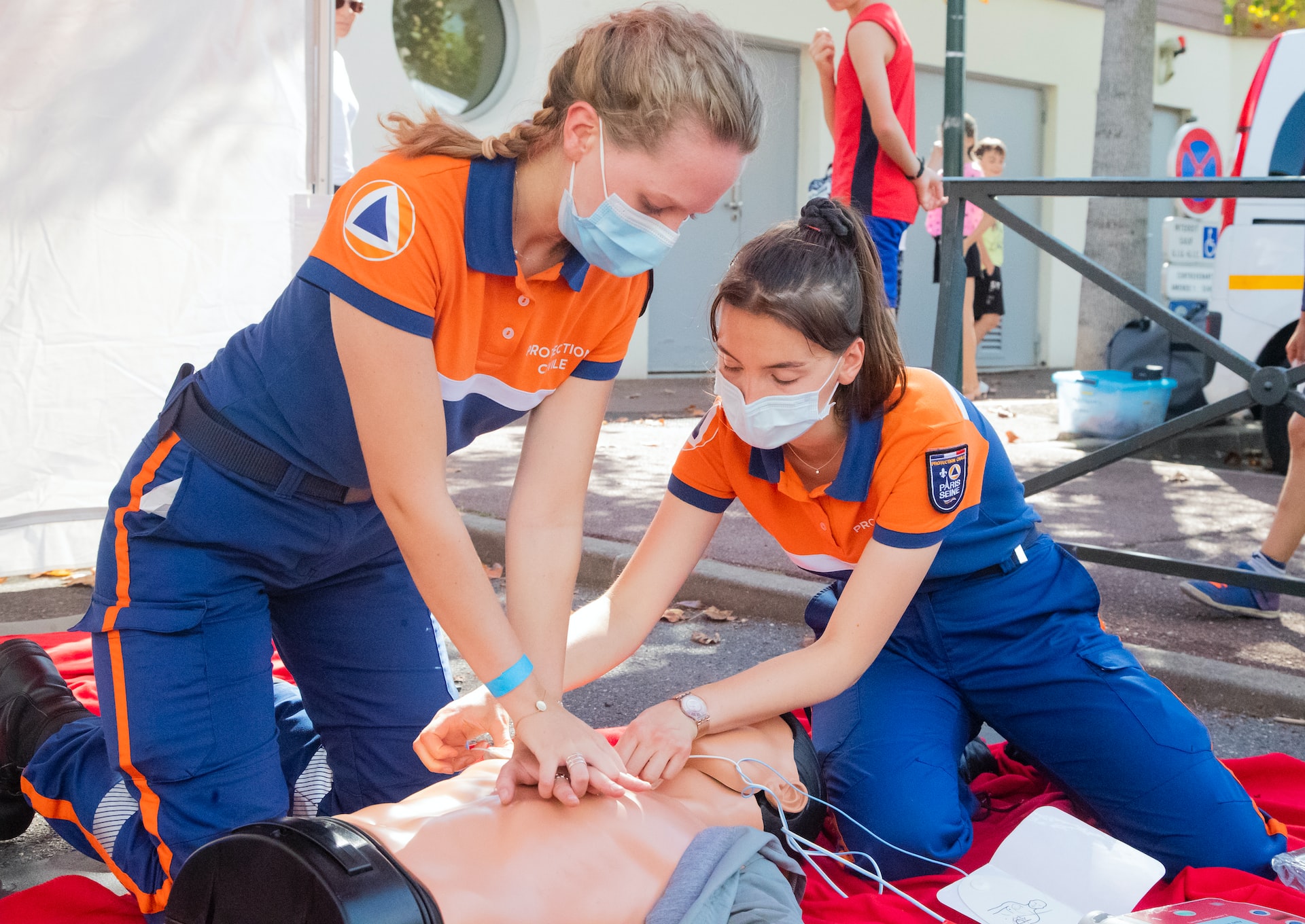Last Updated on January 22, 2024
The American Red Cross implemented newly released first aid and CPR guidelines into training programs. The new Guidelines for First Aid co-developed by the American Red Cross and American Heart Association released on November 28, 2005, as well as the new CPR Guidelines.
The new improved method was based on new scientific evidence that is not incorrect nor harmful, making it easier for the public to learn CPR and other life-saving skills.
“We are enthusiastic about the new ‘simpler is better’ approach endorsed by research and scientific experts along the country.” Says Scott Conner, Vice President of American Red Cross Products and Health and Safety Services. “If learning and remembering these new skills is easier, we feel that the average person will have more confidence to respond to an emergency, and more lives will be saved.”
Control of bleeding is one of the most significant changes in training education resulting from the first aid guidelines. It is considered as one of the few actions by which a person can critically influence an outcome of first aid. The current recommendation was a combination of direct pressure, elevation, and using pressure points to stop bleeding whereas in the new guidelines recommend applying direct pressure to the bleeding area until bleeding stops or Rescuers arrive. Methods applying pressure include the following:
• Using manual pressure on gauze or other cloth placed over the bleeding source; adding more gauze and pressure if bleeding continues.
• Using an elastic bandage firmly wrapped over the gauze to hold it in place.
Reference: The American National Red Cross, December 09, 2005
PART 1: THE FIRST AID GUIDELINES 2005 CHANGES AND HIGHLIGHTS FOR THE LAY RESPONDERS
The 2005 American Heart Association Guidelines for Cardiopulmonary Resuscitation and Emergency Cardiovascular Care and the 2005 American Red Cross/ American Heart Association Guidelines for First Aid have brought about a number of changes that impact Red Cross training programs. The table below provides an overview of those changes but is intended to provide a brief look at some of the important changes to Red Cross courses.
Additional information on first aid and CPR guidelines and their impact on training courses will be posted to www.redcross.org as soon as it becomes available.
| OLD | NEW | |
| Rescue Breaths | Deep breath at 2 sec/breath | Normal breath given over 1 sec until chest rises |
| Chest compression to ventilation ratio | 15:2 – Adults5:1 – Child5:1 – infant | 30:2 – Adult/ Child/ Infant |
| Chest Compression Rate | About 100/minute-child/AdultAbout 120/minute- Infant | 100/minute- Adult/Child/Infant |
| Chest Compression Land Marking Method | Trace up the ribs- Adult/ChildOne finger width below the nipple line at the center of the chest- Infant | Simplified approach- Center of the chest- Adult/Child Just below the nipple line at the center of the chest- Infant |
| AED – Automated External Defibrillator | Up to three shocks, then 1 minute CPR | 1 shock , then 2 minute CPR(or 5 cycles) of CPR |
| Bleeding | Direct pressure, elevation, pressure points | Direct pressure only |
| Anaphylaxis | Assist the person with the use of the prescribed auto-injector | |
| Asthma | Assist the person with the use of a prescribed inhaler |
Note to Red Cross Instructors: These Changes will be reflected in the revised materials to be released beginning in spring 2006. Red Cross Instructors may not teach or adapt the current materials to reflect the new skills and guidelines.
PART 2: AMERICAN RED CROSS 2005 GUIDELINES FOR EMERGENCY CARE AND EDUCATION
INTRODUCTION
This represents American Red Cross (ARC) interpretations of the 2005 International Consensus on Science with Treatment Recommendations (CoSTR) for cardiopulmonary resuscitation (CPR) and automated external defibrillators (AED) and is based on the review of the current input of the American Red Cross volunteers and professional staff.
LEVELS OF TRAINING
For the purpose of organizing its training programs in terms of appropriate knowledge and skill levels, the American Red Cross recognizes three levels of responders in emergency care situations. While establishing different levels of training to meet the needs of different categories of responders, these categories are not meant to set up exclusive support to individuals taking any course or program based upon interest as well as needs.
PROFESSIONAL RESCUER (LEVEL 1)
Any person with formal training who has a primary professional duty to respond to emergencies, such as lifeguards, police officers, athletic trainers, firefighters, and other first responders.
CERTIFIED LAY RESCUER (LEVEL 2)
A person with some formal training who has a secondary, i.e., workplace-related duty-to-act, as designated by job or position responsibilities including workplace emergency response or first aid team members, flight attendants, security guards, teachers, and childcare providers.
LAY COMMUNITY RESPONDER (LEVEL 3)
Any person with either some or no formal training has no duty to act. This person could be a bystander, a family member or any individual in the community who decides on first aid or emergency care.
AGE DELINEATION
The delineation of age has been traditionally arbitrary in nature and does not completely reflect patterns of injury and illness. In addition, responders may find exact age determination difficult. As a result, the American Red Cross has established age categories for emergency care which are based on epidemiological patterns of injury including acre needed, while at the same time being easy to recognize based on the person’s appearance.
In general, infants and children suffer respiratory emergencies which if untreated can lead to cardiac emergencies. Adolescents and adults will often suffer primary cardiac events. Lastly, an individual can look at a victim and determine if they are an infant, a child, or an adult. While on occasion, an individual may categorize a large 13-year-old as a child, this would not have any significant impact on care and would be far outweighed by the ease of recognition.
Based on this physiological, epidemiological, and recognition approach. The following general age groups have been developed. While these categories of age are based on the appearance of broad categories of children, specific ages are given should age be readily known.
Infant – Is anyone who appears to be under 1 year of age.
Child – Anyone who appears to be between the ages of 1 year and about 12 years of age.
For AED, based on FDA approval of these devices—a child is considered between the ages of 1 and 8 or less than 55 pounds. If precise age weight is not known the responder should use his or her best judgment and not delay care in determining age.
Adult – Is anyone approximately 12 years old or older?
PART 3: EDUCATION
The new American Red Cross First aid/ CPR/ AED materials reflect changes based on scientific findings in the field of resuscitation as described in the 2005 International Consensus on CPR and Emergency Cardiovascular Care Science with Treatment Recommendations, plus research findings in education. It is the result of several years of research and testing to discover more effective ways to teach skill retention.
This summary addresses the following:
• The American Red Cross Response Readiness Model
• Skill retention and length of certification
• Simplification of CPR skill sequences that make training easier, improves retention and builds students’ confidence so they are more likely to provide appropriate care in emergency situations.
• The Practice-While-You-Watch skill instruction method, makes it easier for instructors to provide individual feedback and increased in-class practice time as needed, thereby improving skill acquisition and retention.
AMERICAN RED CROSS RESPONSE AND READINESS MODEL
Red Cross has developed a conceptual model based on the Theory of Reasoned Action (Azjen and Fishbein, 1980). This theory describes the process through which new information and education influence behavior.
Response to Readiness
SKILL RETENTION
A review of the research on training intervals found documented decay in the skills of health care providers after intervals as short as six weeks and as long as two years (ILOCOR, 2005). Although the evidence evaluation recognizes that frequent retraining is necessary to maintain skills, the research did not define optimal intervals for retraining. In a separate review of 28 training studies pertaining to CPR skills retention, The Red Cross (Gallagher, 2002) found no evidence to support two years as an adequate interval between training. Some studies questioned whether one year was too long (Fossel, et. al, 1983; Gass and Curry, 1983). Many studies (e. g Berden, et al,1994; Braun 2002; Dracup, et al,1998) pointed to the need for frequent education, reviews, and skill practice. None of the study reviewed found sufficient skill retention in health care professionals beyond six months (Gallagher, 2002).
SIMPLIFICATION OF SKILL SEQUENCES
Two components essential to the performance of CPR skills
• Acquisition of Skills Through Training
• Retention of the Learned Skills After Training
Because CPR involves many steps, decision points, and distinct skills, students have more trouble learning CPR than they do less complex skill sets.
To make instruction of CPR more effective and encourage retention, CPR skills steps have been simplified as described below. (ILOCOR, 2005)
A. UNIVERSAL COMPRESSION-VENTILATION RATIO
One universal compression-ventilation ratio for adults, child,ren and infants is 30:2
This limits the time between compressions and breaths and increases the number of compressions given in one minute.
Because professional rescuers and experienced and perform the skills frequently, ILOCOR (Biaret ,et al, 2005; Handley, et al,200; ILOCOR 2005) concluded that they could learn and remember more complicated algorithms (I.e., they follow a 15:2 ratio for 2-person CPR for children and infants)
B. HAND PLACEMENT
Hand placement in the middle of the chest (ILOCOR, 2005; Handley et al.,2005)
Because hand placements affect the quality of CPR and because rescuers need to position their hands to give compressions as quickly as possible in order to minimize interruptions,ILOCOR (2005) recommended simplifying instruction on hand placement with less details in anatomical landmarking by giving students the simple instructions to “place your hands in the center of the chest”.
“PRACTICE-WHILE-YOU-WATCH” VIDEO INSTRUCTION
Numerous CPR outcome studies have indicated that laypeople’s CPR skills acquisition and retention are poor after traditional classroom training (Chamberlain & Hazinski, 2003) ILOCOR (Chamberlain & Hazinski,2003; ILOCOR,2005) recommends not restriction CPR instruction methods to traditional techniques. Newer educational strategies, such as video self-instruction programs, may be more effective at getting students to practice skills immediately and performing better on skills tests immediately following instruction (Braslowet al, 1997; Todd et al, 1998; Knoxs et al, 1999; Batcheller et al, 2000).
With the practice-while -you watch method, students benefit from the value of video self-instruction plus increased individual instructor feedback and assessment during training. The use of video instruction in the classroom setting allows students to learn from improved video instruction while gaining certification so many may need to meet workplace requirements.
The Red Cross evaluated “practice-while-you-watch” in several trials while the program was in development. After each classroom test, the video and training were revised to incorporate improvements to the course. Tests and methods have shown that students are fully and enthusiastically engaged in skill practice without some of the hesitations that have been observed in the past. The data that has been collected so far confirms that student outcomes, including learning, are at least as good in the new method as in the old method. Initial skills testing comparing the use of a small segment of “practice-while-you-watch” with traditional skill instruction showed that students in 14 out of 25 CPR skills tested, and better than the traditionally trained students in 11 out of 25 skills tested.
Future research will reveal more about how innovation improves skill performance and skill retention.
PART 4: SIMPLIFIED CPR PRACTICAL APPLICATION
Easy and simple step-by-step guidelines for an effective CPR procedure.
CPR FOR ADULT
Here are the easy and simple step-by-step guidelines for an effective CPR procedure.
• CALL
Check the victim for responsiveness. If there is no response, call emergency numbers listed in the designated country authority then return to the victim. In most locations, the emergency dispatcher can assist you with CPR instructions.
• BLOW
Tilt the head back and listen for breathing. If not breathing normally, pinch the nose and cover the mouth with yours and blow until you see the chest rise. Give 2 breaths each. Each breath takes 1 second.
Normally it takes 1 initial breath to check the airway.
• PUMP
If the victim is still not breathing normally, coughing, or moving, begin the chest compressions. Push down on the chest 1 to 1½ inches below the sternum (tip of the ribcage at the center of the chest) 30 times using the base of your palm. The depth of each compression should not exist 1 inch to avoid the sternum from crashing.
Pump at a rate of 100/ minute, faster than one per second.
Perform 6 rounds of breaths and 5 cycles of chest compression then check the pulse after.
Continue CPR until help arrives.
Note: The ratio is the same for one-person and two-person CPR. In two-person CPR, the person pumping the chest stops while the other gives mouth-to-mouth breathing.
Check the pulse. If the pulse is present along with shallow breathing, DO NOT PERFORM CPR.
CPR FOR CHILDREN AGES 1-8
CPR for children is similar to CPR for adults. The compression to ventilation ratio is 30:2 at 5 cycles. However, there are 3 differences.
• By checking the physiological development of the child, you can determine when to use an over-lapping palm position or a single palm chest compression.
• By carefully placing the heel of one palm instead of two for chest compressions.
• Press the sternum approximately one-third of the depth on the chest.
CPR FOR INFANTS AGE LESS THAN 1
• Shout and gently tap the child on the shoulder and gently position the child on the ground. If there is no response, check pulse and signs of breathing.
• Open the airway by lifting the chin and tilting the head. Make sure not to tilt the head far back.
• Give 2 gentle breaths. Each breath should be 1 second long. Always check if the chest rises, if not, check for number 2.
• Give 30 compressions
Give 30 gentle compressions using two or three of your fingers in the center of the chest just below the nipple line. Press down approximately one-third of the depth in each compression.
• Repeat for two minutes. After two minutes of repeated cycle call emergency numbers and continue CPR until help arrives.
FIRST AID FOR A CHOKING CONSCIOUS AND UNCONSCIOUS CHILD & ADULT
• Determine id the person can speak of cough. If not, proceed to the next step.
• Perform an abdominal thrust (Heimlich Maneuver) repeatedly until the foreign body is expelled.
• A chest thrust may be used for a markedly obese person or in the late stage of pregnancy.
• If the adult or child became unconscious, check for pulse and breathing. If these two signs are not present, perform CPR.
• Gently lay the victim on the ground and perform CPR, always check the foreign object if expelled every 1 cycle ( 2 breaths, 30 chest compressions). If the foreign object is present, remove it by scooping the object using your finger.
FIRST AID FOR CHOKING CONSCIOUS INFANT LESS THAN ONE-YEAR-OLD
• Determine if the infant can cough or cry. If not, proceed to the next step.
• Gently position the infant facing the ground, resting on your arm or lap. Give blows using the heel of your palm at the infant’s back between the scapula.
• Give five chest thrusts using two or three of your finger.
• Repeat steps 2 & 3 until the foreign object is expelled. If the infant became unconscious check for pulse and breathing as stated in CPR FOR INFANT. then check the throat or mouth for the foreign object after every cycle ( 2 breaths: 30 chest compressions). If the foreign body has been expelled and the infant is still unconscious perform CPR.
References:
Azjen, I. & Fishbein,1980 Englewoods Cliffs , NJ : Prentice Hall
Batcheller, A.M, Brennan, R.T., Braslow,A., Urrutia, A.,& Kaye, W.,2000
Berden,H.J., Bierens,J.J., Willems, F.F., Hendrick,J.m., Pijls, N.H., & Knape, J.t.,1994 Annals of Emergency Medicine
Biarent,d., Bingham, R., Richmond ,S., Maconochie, I. , Wyllie, J., Simpson, S., Rodriguez Nunez,A., & Zideman,D.,2005 Pediatric Life Support, Resuscitation, 67S1, S97-S133.
Braslow, A., Brennan, R.T., Newman, M.M., Bircher, N.G., Batcheller, A.M.,& Kaye.w.,1997: CPR Training without Instructor: Development and evaluation of a video self-instructional system for effective performance of cardiopulmonary resuscitation.
Chamberlain, D.A., & Hazinski, M.F. on behalf of European Resuscitation Council, The American Heart Association, Heart Association Foundation of Canada, The Australia and New Zealand Resuscitation Council, The Resuscitation Council of South Africa, The Consejo Latino-Americano De Resuscitacion. 2003 ILOCOR advisory Statement: Education in Resuscitation.
Dracup, K., Moser, D., Doering, L., & Evangelista, L. 1998 Retention and use of cardiopulmonary resuscitation skills in parents of infants at risk for cardiopulmonary arrest, Pediatric Nursing.
Todd, K.H., Braslow, A., Brenan, R.T., Lowery, D.W., Cox, R.J., Lipscomb, L.E., Kellerman, A.L., 1998. Randomized, controlled trial of video self-instruction versus traditional CPR training, Annals of Emergency Medicine.







